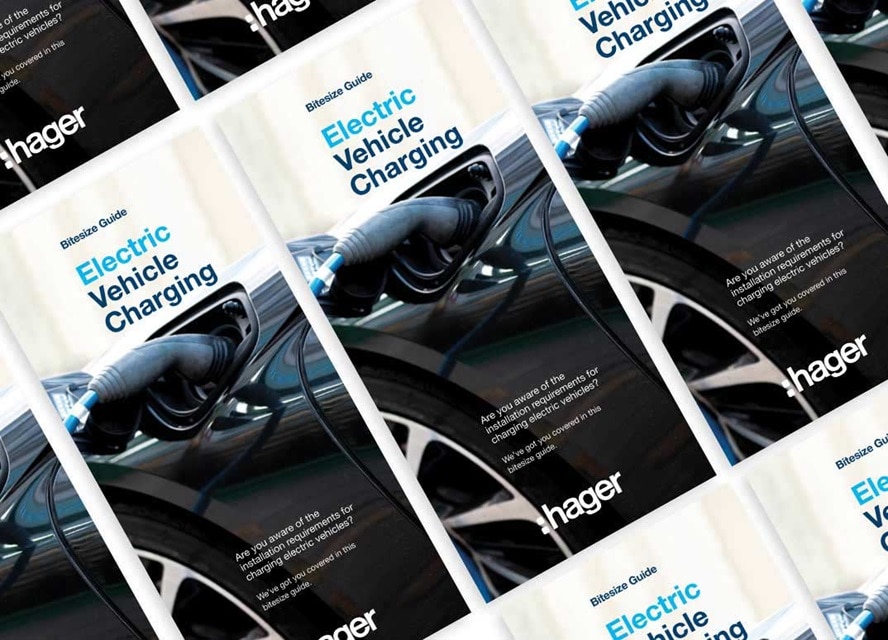EV Charging and RCDs
Paul Collins, Technical and Training Manager at Hager covers key topics relating to the supply of electrical charging equipment and the appropriate method for connecting a car charging circuit.

RCD Requirements For EV Charging
The requirements for charging electric vehicles were the subject of amendment 1 to BS 7671 issued in Feb 2020 and came into effect in July 2020. This has been further revised with Amendment 2 in 2022. Paul Collins, Technical and Training Manager here at Hager covers key topics relating to the supply of electrical charging equipment and the appropriate method for connecting a car charging circuit.
Are RCDs required to supply a car charger?
Yes, regulation 722.531.3 requires that an RCD (Max 30mA) supplies a car charger and the RCD shall disconnect all live conductors. This includes the Neutral therefore the single-pole RCBOs should not be used for this application. Amendment 2 also introduced the requirement to individually protect the car charger with an RCD so this RCD should not serve circuits in addition to the car charger
Some car charger manufacturers quote an RDC-DD, what is this?
An RDC-DD is a ‘Residual Direct Current – Detecting Device’. This is often built within the car charger equipment to monitor and if necessary disconnect should any DC problems appear on the AC side of the installation, which could affect the operation of RCDs
If a car charger does not have any RDC-DD then what type of RCD is required?
If the car charger does not have any RDC-DD then you will need a Type B RCD supplying the car charger. This is because Type B can detect this DC, still work and disconnect if required.
What type of RCD should be used if the car charger has an RDC-DD that will detect and disconnect any DC issues above 6mA?
In this case, a Type A RCD can be used. This is because Type A can still work correctly up to a level of 6mA DC. Over 6mA however, this Type-A device could be affected and possibly blinded and potentially stop working. This is the preferred option as Type A are now very common and lowest price. Therefore most car charger manufacturers have a 6mA RDC-DD built-in.
RCD in a series:
In some scenarios, someone may supply a car charger from an existing installation where they may consider installing from a spare way in the consumer unit. If there is no space for the new Type A RCD, they may consider installing this closer to the car charger.
The type A RCD will not be affected by DC up to 6mA. However, it’s important to consider the time frame of when the RCD was installed in the consumer unit. If it was installed some time ago, it could be a Type AC. This RCD may be also supplying other circuits within the house which could then be affected or in some cases blinded by any DC that may be coming from the car. These other circuits then may not have any residual current protection, the consequences of which could be severe.
View in ECN's March 2021 issue here
Bitesize Guide: EV car charging
Our guide looks at the requirements of BS 7671 and the product standard BS EN 61439-3 regarding Electric Vehicle Charging.
Latest news
Keep up to date
Make sure you're "in the know" on the latest Hager and electrical industry news.
FAQ
-
What types of RCDs are used for an EV charger?
Firstly any RCD associated with an EV charger must disconnect all live conductors.
Each charging point incorporating a socket-outlet or vehicle connector shall be protected individually by an RCD of Type A, Type F or Type B and having a rated residual operating current not exceeding 30 mA. Where the EV charging equipment incorporates protection against DC fault currents in excess of 6mA by means of a Residual Direct Current Detecting Device (RDC-DD) then a Type A is suitable to supply this equipment
-
What circuit breaker do I need for an EV charger?
It is important to seek the advice of the consumer unit assembly manufacturer as a car charger is a type of circuit that is continually loaded and as such, depending on the circuit protection device’s position within the consumer unit, may require de-rating. Hager have carried out rigorous tests and would recommend a 40 A protective device to supply the usual 7 kW domestic charger
-
Why do car chargers need a type A RCD?
Car chargers for electric vehicles (EVs) will likely need a Type A Residual Current Device (RCD) for safety reasons. The car being essentially DC could superimpose DC fault currents on the supply. If a Type AC device is used this could be blinded by this DC and not operate causing real safety issues. Type A devices are immune to DC up to a level of 6 mA which is why they are suitable where the car charging equipment incorporates an RDC-DD of 6 mA. Type F or Type B devices may be required where this RDC-DD differs or is not incorporated. It is therefore essential to seek the advice of the car charging equipment manufacturer
-
When should an RCD be used?
A Residual Current Device (RCD) is a safety device used in electrical installations to protect against electric shock, electrocution and fire caused by earth faults. RCDs are designed to quickly detect and disconnect the electrical supply in the event of an earth fault, providing additional protection beyond that provided by fuses or circuit breakers.
In terms of when an RCD should be used, please refer to BS7671:2018+Amd2 :2022




